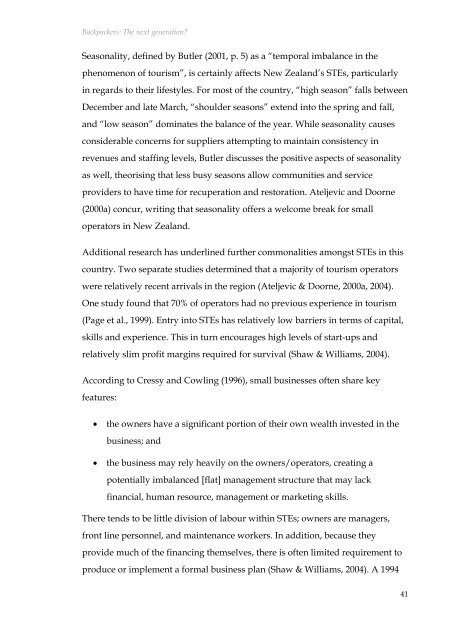Backpackers: The next generation? - Scholarly Commons Home
Backpackers: The next generation? - Scholarly Commons Home
Backpackers: The next generation? - Scholarly Commons Home
You also want an ePaper? Increase the reach of your titles
YUMPU automatically turns print PDFs into web optimized ePapers that Google loves.
<strong>Backpackers</strong>: <strong>The</strong> <strong>next</strong> <strong>generation</strong>?<br />
Seasonality, defined by Butler (2001, p. 5) as a “temporal imbalance in the<br />
phenomenon of tourism”, is certainly affects New Zealand’s STEs, particularly<br />
in regards to their lifestyles. For most of the country, “high season” falls between<br />
December and late March, “shoulder seasons” extend into the spring and fall,<br />
and “low season” dominates the balance of the year. While seasonality causes<br />
considerable concerns for suppliers attempting to maintain consistency in<br />
revenues and staffing levels, Butler discusses the positive aspects of seasonality<br />
as well, theorising that less busy seasons allow communities and service<br />
providers to have time for recuperation and restoration. Ateljevic and Doorne<br />
(2000a) concur, writing that seasonality offers a welcome break for small<br />
operators in New Zealand.<br />
Additional research has underlined further commonalities amongst STEs in this<br />
country. Two separate studies determined that a majority of tourism operators<br />
were relatively recent arrivals in the region (Ateljevic & Doorne, 2000a, 2004).<br />
One study found that 70% of operators had no previous experience in tourism<br />
(Page et al., 1999). Entry into STEs has relatively low barriers in terms of capital,<br />
skills and experience. This in turn encourages high levels of start-ups and<br />
relatively slim profit margins required for survival (Shaw & Williams, 2004).<br />
According to Cressy and Cowling (1996), small businesses often share key<br />
features:<br />
• the owners have a significant portion of their own wealth invested in the<br />
business; and<br />
• the business may rely heavily on the owners/operators, creating a<br />
potentially imbalanced [flat] management structure that may lack<br />
financial, human resource, management or marketing skills.<br />
<strong>The</strong>re tends to be little division of labour within STEs; owners are managers,<br />
front line personnel, and maintenance workers. In addition, because they<br />
provide much of the financing themselves, there is often limited requirement to<br />
produce or implement a formal business plan (Shaw & Williams, 2004). A 1994<br />
41

















